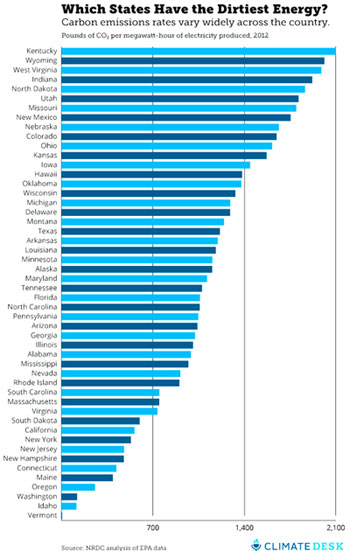After the EPA announced power plant regulations yesterday, China upped the ante, saying it will set an absolute nationwide cap on carbon emissions starting in 2016.
This immediate response to US action shows how easy it would be to spark a competition on which countries can clean up the environment fastest.
Reuters reports the Chair of China’s Advisory Committee on Climate Change, He Jiankun, says the cap will be part of China’s next five-year plan, which starts that year. Carbon emissions will be controlled both by reducing carbon intensity and by an absolute cap, he says.
More Details on EPA power plant regulations
During her speech announcing the regulations, Administrator Gina McCarthy said she wants to "turn climate risk into business opportunity" and that the rules will be a boon for clean energy.
True, the rules will be the biggest stimulus for renewable energy since the $90 billion in the Recovery Act, but natural gas could expand even more rapidly, which she also counts as "clean energy."
It all depends on what carbon reduction targets end up being for each state, and they will be wildly different from each other. McCarthy says they will be set based on a state’s current energy profile – how easy or difficult it will be for them to move from outdated coal plants.
After the comment period is over, state targets could change significantly. There will lots of give and take with the states, she says.
Tom come up with this initial proposal, EPA first looked at whether existing coal plants can’t be upgraded – if not, can they switch to natural gas? After that, efficiency and renewables come in, adopted more easily by some states than others. The final decision on what a state does, however, is in its hands, not the EPA’s.
Washington State will have to reduce CO2 per unit of electricity (carbon intensity) by 72%, Arizona by 52%; Maine by 13.5% and North Dakota by 10.6%, for example.
Why is Washington State’s reduction target so high? Because it’s already on a path to vastly reduce emissions, so the state can contribute more to the national goal than very coal-dependent states like Kentucky. North Dakota is low because there’s so much natural gas there.
When you add up all state targets, carbon emissions across US power plants will be down by 30% by 2030 (from 2005 levels).

EPA expects non-hydro renewables to grow 67% because of the law – to 21,000 gigawatts by 2030, conservatively – while coal generation declines 20%. If Congress allows the Investment Tax Credit to expire in 2017, solar subsidies will end, and the carbon rule will be much more important for the industry’s growth.
One thing is for sure, it will spark innovation, and some are already talking about a price on carbon. Great River Energy, a Minnesota electric coop, for example, suggests nearby states set a common price on carbon for the wholesale electric market. That alone would change the game. Instead of utilities buying coal because it’s the cheapest, they would buy cleaner energy sources that cost less, reports Bloomberg.
60% Toward Our Carbon Reduction Goal
While many complain the rules either don’t go far enough (environmental groups) or will kill the economy (you know who), from our point of view, we can’t depend on any one measure to deal with climate change.
Taken together, Obama’s success at boosting fuel economy for cars and trucks combined with power plant rules, means he has "addressed more than 60% of US carbon pollution, Dan Lashof, COO of NextGen Climate America, told the Washington Post. Then there’s a litany of other programs, from his Better Buildings Challenge to executive orders like directing every federal agency to get 20% of energy from renewables by 2020.
EPA’s power plant rules will cut 550 million metric tons of carbon emissions a year, while fuel efficiency standards will cut 580 million metric tons a year by 2030.
No, the rules won’t "get the world to where it has to go to avert the worst consequences of climate change. But they are likely to be enormously beneficial: good for the nation’s health, good for technological innovation, good for President Obama’s credibility abroad, and, in time, good for the planet and future generations," says the New York Times Editorial Board. "The importance of this [rule] cannot be overstated – it signals the end of an era in which polluters could dump greenhouse gases into the atmosphere without penalty."
Here is EPA’s map of how each state will be impacted:

